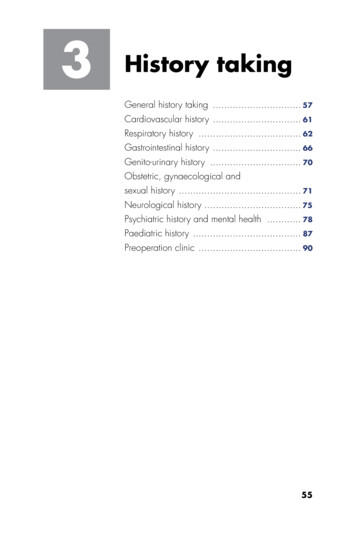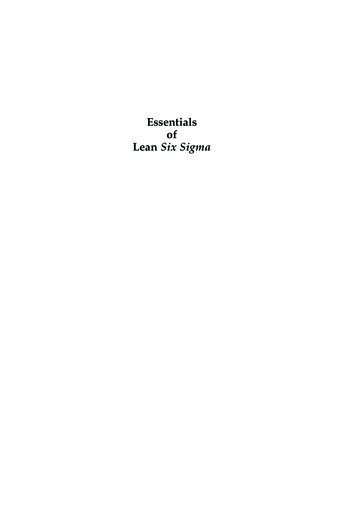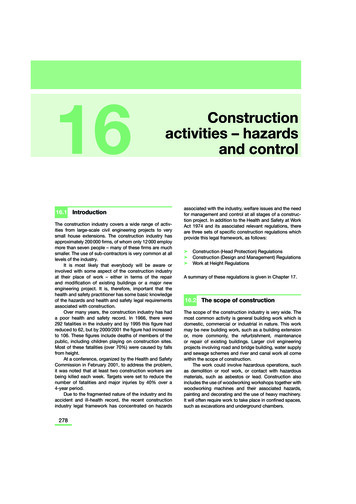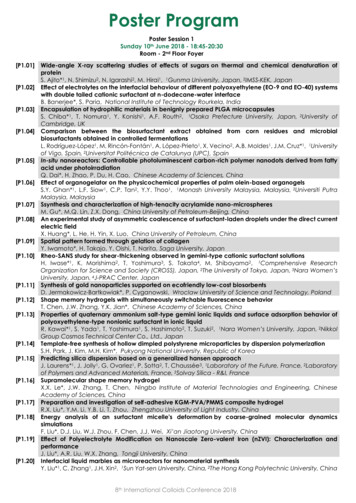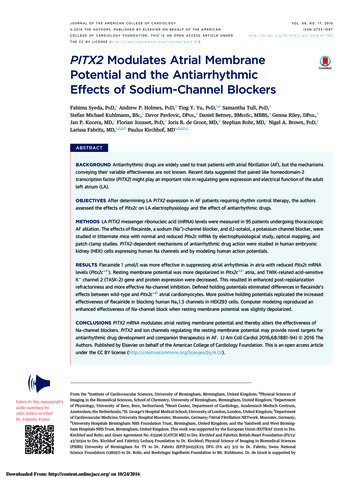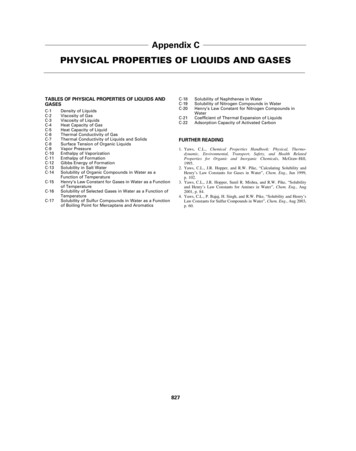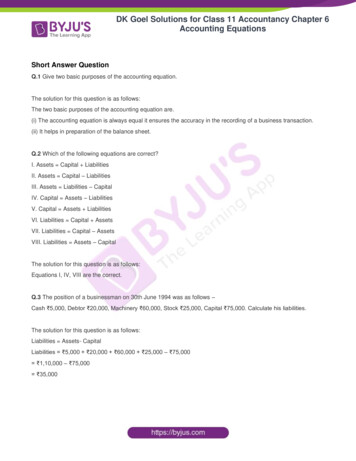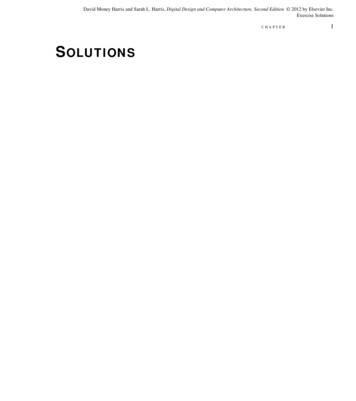
Transcription
David Money Harris and Sarah L. Harris, Digital Design and Computer Architecture, Second Edition 2012 by Elsevier Inc.Exercise SolutionsCHAPTERSOLUTIONS1
David Money Harris and Sarah L. Harris, Digital Design and Computer Architecture, 2nd Edition 2012 by Elsevier Inc.Exercise SolutionsSOLUTIONSCHAPTER 1Exercise 1.1(a) Biologists study cells at many levels. The cells are built from organellessuch as the mitochondria, ribosomes, and chloroplasts. Organelles are built ofmacromolecules such as proteins, lipids, nucleic acids, and carbohydrates.These biochemical macromolecules are built simpler molecules such as carbonchains and amino acids. When studying at one of these levels of abstraction, biologists are usually interested in the levels above and below: what the structuresat that level are used to build, and how the structures themselves are built.(b) The fundamental building blocks of chemistry are electrons, protons,and neutrons (physicists are interested in how the protons and neutrons arebuilt). These blocks combine to form atoms. Atoms combine to form molecules.For example, when chemists study molecules, they can abstract away the lowerlevels of detail so that they can describe the general properties of a moleculesuch as benzene without having to calculate the motion of the individual electrons in the molecule.Exercise 1.3Ben can use a hierarchy to design the house. First, he can decide how manybedrooms, bathrooms, kitchens, and other rooms he would like. He can thenjump up a level of hierarchy to decide the overall layout and dimensions of thehouse. At the top-level of the hierarchy, he material he would like to use, whatkind of roof, etc. He can then jump to an even lower level of hierarchy to decidethe specific layout of each room, where he would like to place the doors, windows, etc. He can use the principle of regularity in planning the framing of thehouse. By using the same type of material, he can scale the framing dependingon the dimensions of each room. He can also use regularity to choose the same(or a small set of) doors and windows for each room. That way, when he places1
David Money Harris and Sarah L. Harris, Digital Design and Computer Architecture, Second Edition 2012by Elsevier Inc. Exercise Solutions2SOLUTIONSchapter 1a new door or window he need not redesign the size, material, layout specifications from scratch. This is also an example of modularity: once he has designedthe specifications for the windows in one room, for example, he need not respecify them when he uses the same windows in another room. This will savehim both design time and, thus, money. He could also save by buying someitems (like windows) in bulk.Exercise 1.5(a) The hour hand can be resolved to 12 * 4 48 positions, which representslog248 5.58 bits of information. (b) Knowing whether it is before or after noonadds one more bit.Exercise 1.7216 65,536 numbers.Exercise 1.9(a) 216-1 65535; (b) 215-1 32767; (c) 215-1 32767Exercise 1.11(a) 0; (b) -215 -32768; (c) -(215-1) -32767Exercise 1.13(a) 10; (b) 54; (c) 240; (d) 2215Exercise 1.15(a) A; (b) 36; (c) F0; (d) 8A7Exercise 1.17(a) 165; (b) 59; (c) 65535; (d) 3489660928Exercise 1.19(a) 10100101; (b) 00111011; (c) 1111111111111111;(d) 11010000000000000000000000000000
David Money Harris and Sarah L. Harris, Digital Design and Computer Architecture, 2nd Edition 2012 by Elsevier Inc.Exercise SolutionsSOLUTIONSExercise 1.21(a) -6; (b) -10; (c) 112; (d) -97Exercise 1.23(a) -2; (b) -22; (c) 112; (d) -31Exercise 1.25(a) 101010; (b) 111111; (c) 11100101; (d) 1101001101Exercise 1.27(a) 2A; (b) 3F; (c) E5; (d) 34DExercise 1.29(a) 00101010; (b) 11000001; (c) 01111100; (d) 10000000; (e) overflowExercise 1.3100101010; (b) 10111111; (c) 01111100; (d) overflow; (e) overflowExercise 1.33(a) 00000101; (b) 11111010Exercise 1.35(a) 00000101; (b) 00001010Exercise 1.37(a) 52; (b) 77; (c) 345; (d) 1515Exercise 1.39(a) 1000102, 2216, 3410; (b) 1100112, 3316, 5110; (c) 0101011012, AD16,17310; (d) 0110001001112, 62716, 157510Exercise 1.4115 greater than 0, 16 less than 0; 15 greater and 15 less for sign/magnitude3
David Money Harris and Sarah L. Harris, Digital Design and Computer Architecture, Second Edition 2012by Elsevier Inc. Exercise Solutions4SOLUTIONSchapter 1Exercise 1.434, 8Exercise 1.455,760,000EExercise 1.4746.566 gigabytesExercise 1.49128 kbitsExercise 1.51-2-1012300011011110001Two's Complement11001001Sign/MagnitudeUnsigned10Exercise 1.53(a) 11011101; (b) 110001000 (overflows)Exercise 1.55(a) 11011101; (b) 110001000Exercise 1.57(a) 000111 001101 010100(b) 010001 011001 101010, overflow(c) 100110 001000 101110
David Money Harris and Sarah L. Harris, Digital Design and Computer Architecture, 2nd Edition 2012 by Elsevier Inc.Exercise SolutionsSOLUTIONS(d) 011111 110010 010001(e) 101101 101010 010111, overflow(f) 111110 100011 100001Exercise 1.59(a) 0x2A; (b) 0x9F; (c) 0xFE; (d) 0x66, overflowExercise 1.61(a) 010010 110100 000110; (b) 011110 110111 010101; (c) 100100 111101 100001; (d) 110000 101011 011011, overflowExercise ise 1.65(a) 0011 0111 0001(b) 187(c) 95 1011111(d) Addition of BCD numbers doesn't work directly. Also, the representation doesn't maximize the amount of information that can be stored; for example2 BCD digits requires 8 bits and can store up to 100 values (0-99) - unsigned 8bit binary can store 28 (256) values.Exercise 1.67Both of them are full of it. 4210 1010102, which has 3 1’s in its representation.Exercise 1.69#include stdio.h void main(void){char bin[80];int i 0, dec 0;printf("Enter binary number: ");scanf("%s", bin);5
David Money Harris and Sarah L. Harris, Digital Design and Computer Architecture, Second Edition 2012by Elsevier Inc. Exercise Solutions6SOLUTIONSchapter 1while (bin[i] ! 0) {if (bin[i] '0') dec dec * 2;else if (bin[i] '1') dec dec * 2 1;else printf("Bad character %c in the number.\n", bin[i]);i i 1;}printf("The decimal equivalent is %d\n", dec);}Exercise 1.71OR3ABCXOR3ABCYY A B CA00001111(a)B00110011C01010101ABCDYY A B cise 1.73Exercise 1.75B00110011C01010101YY A B C D(b)A00001111XNOR4Y00010111A000000001111111(c) 01Y1001011001101001
David Money Harris and Sarah L. Harris, Digital Design and Computer Architecture, 2nd Edition 2012 by Elsevier Inc.Exercise 1010Exercise 1.7722NExercise 1.79No, there is no legal set of logic levels. The slope of the transfer characteristic never is better than -1, so the system never has any gain to compensate fornoise.Exercise 1.81The circuit functions as a buffer with logic levels VIL 1.5; VIH 1.8; VOL 1.2; VOH 3.0. It can receive inputs from LVCMOS and LVTTL gates because their output logic levels are compatible with this gate’s input levels. However, it cannot drive LVCMOS or LVTTL gates because the 1.2 VOL exceedsthe VIL of LVCMOS and LVTTL.Exercise 1.83(a) XOR gate; (b) VIL 1.25; VIH 2; VOL 0; VOH 3Exercise 1.857
David Money Harris and Sarah L. Harris, Digital Design and Computer Architecture, Second Edition 2012by Elsevier Inc. Exercise Solutions8SOLUTIONSchapter 1YAABABBCYYACB(b)(a)(c)Exercise 1.87XORA0011B0101Y0110Exercise 1.89weakweakYYweakYABAAC(a)BBC(b)C(c)Question 1.1ABCDY
David Money Harris and Sarah L. Harris, Digital Design and Computer Architecture, 2nd Edition 2012 by Elsevier Inc.Exercise SolutionsSOLUTIONSQuestion 1.317 minutes: (1) designer and freshman cross (2 minutes); (2) freshman returns (1 minute); (3) professor and TA cross (10 minutes); (4) designer returns(2 minutes); (5) designer and freshman cross (2 minutes).9
David Money Harris and Sarah L. Harris, Digital Design and Computer Architecture, 2nd Edition 2012 by Elsevier Inc.Exercise SolutionsSOLUTIONSCHAPTER 2Exercise 2.1(a) Y AB AB AB(b) Y ABC ABC(c) Y ABC ABC ABC ABC ABC(d)Y ABCD ABCD ABCD ABCD ABCD ABCD ABCD(e)Y ABCD ABCD ABCD ABCD ABCD ABCD ABCD ABCDExercise 2.3(a) Y A B (b)Y A B C A B C A B C A B C A B C A B C (c) Y A B C A B C A B C (d)Y A B C D A B C D A B C D A B C D A B C D A B C D A B C D A B C D A B C D (e)Y A B C D A B C D A B C D A B C D A B C D A B C D A B C D A B C D 11
David Money Harris and Sarah L. Harris, Digital Design and Computer Architecture, Second Edition 2012by Elsevier Inc. Exercise Solutions12SOLUTIONSchapter 2Exercise 2.5(a) Y A B(b) Y ABC ABC(c) Y AC AB AC(d) Y AB BD ACD(e)Y ABCD ABCD ABCD ABCD ABCD ABCD ABCD ABCDThis can also be expressed as:Y A B C D A B C D Exercise 2.7(a)AYB(b)ABCY(c)ACBY
David Money Harris and Sarah L. Harris, Digital Design and Computer Architecture, 2nd Edition 2012 by Elsevier Inc.Exercise SolutionsSOLUTIONS(d)AB C DY(e)ABYCDExercise 2.9(a) Same as 2.7(a)(b)ABCY(c)AB CY13
David Money Harris and Sarah L. Harris, Digital Design and Computer Architecture, Second Edition 2012by Elsevier Inc. Exercise Solutions14SOLUTIONSchapter 2(d)AB C DY(e)ABCDYExercise 2.11(a)ABY(b)ABCY
David Money Harris and Sarah L. Harris, Digital Design and Computer Architecture, 2nd Edition 2012 by Elsevier Inc.Exercise SolutionsSOLUTIONS(c)ACYB(d)ABYDC(e)ABYCDExercise 2.13(a) Y AC BC(b) Y A(c) Y A B C B D BDExercise 2.15(a)ABCY15
David Money Harris and Sarah L. Harris, Digital Design and Computer Architecture, Second Edition 2012by Elsevier Inc. Exercise Solutions16SOLUTIONSchapter 2(b)AY(c)ABDYCExercise 2.17(a) Y B ACBACY(b) Y ABABY(c) Y A BC DEA B CD EYExercise 2.19
David Money Harris and Sarah L. Harris, Digital Design and Computer Architecture, 2nd Edition 2012 by Elsevier Inc.Exercise Solutions17SOLUTIONS4 gigarows 4 x 230 rows 232 rows, so the truth table has 32 inputs.Exercise 2.21Ben is correct. For example, the following function, shown as a K-map, hastwo possible minimal sum-of-products expressions. Thus, although ACD andBCD are both prime implicants, the minimal sum-of-products expression doesnot have both of 010010CDABDABDABCABC110000110000101000101000Y ABD ABC ACDExercise 2.23B200001111Exercise 2.25BCDB100110011B001010101B2 B1 B011111110B2 B1 B011111110Y ABD ABC BCD
David Money Harris and Sarah L. Harris, Digital Design and Computer Architecture, Second Edition 2012by Elsevier Inc. Exercise Solutions18chapter DD011111010111110110ABC111111BD100001100Y ABC DA B00Z ACD BDCDYExercise 2.27Z0
David Money Harris and Sarah L. Harris, Digital Design and Computer Architecture, 2nd Edition 2012 by Elsevier Inc.Exercise SolutionsSOLUTIONSABCDYEFGY ABC D (F G)E ABC D EF EGExercise 2.29Two possible options are shown below:CAYBABCD(a)(b)DExercise 2.31Y AD ABCD BD CD ABCD D A B C Exercise 2.33The equation can be written directly from the description:E SA AL HY19
David Money Harris and Sarah L. Harris, Digital Design and Computer Architecture, Second Edition 2012by Elsevier Inc. Exercise Solutions20chapter 2SOLUTIONSExercise 01010101010100010010010010010011010100010100P has two possible minimal 10110010A1:0011110000001011001111010101000D A3A2A1A0 A3A2A1A0 A3A2A1A0 A3A2A1A0 A3A2A1A0P A3A2A0 A3A1A0 A3A2A1 A2A1A0P A3A1A0 A3A2A1 A2A1A0 A2A1A0Hardware implementations are below (implementing the first minimalequation given for P).
David Money Harris and Sarah L. Harris, Digital Design and Computer Architecture, 2nd Edition 2012 by Elsevier Inc.Exercise SolutionsSOLUTIONSA3A2A1A0DPExercise 2.37The equations and circuit for Y2:0 is the same as in Exercise 2.25, repeatedhere for convenience.A7A6A5A4 010100001XXXXY2 A7 A6 A5 A4Y1 A7 A6 A5 A4 A3 A5 A4 A221
David Money Harris and Sarah L. Harris, Digital Design and Computer Architecture, Second Edition 2012by Elsevier Inc. Exercise Solutions22SOLUTIONSchapter 2Y0 A7 A6 A5 A6 A4 A3 A6 A4 A2 A1A7A6A5A4A3A2A1A0Y2Y1Y0NONE
David Money Harris and Sarah L. Harris, Digital Design and Computer Architecture, 2nd Edition 2012 by Elsevier Inc.Exercise SolutionsSOLUTIONSThe truth table, equations, and circuit for Z2:0 are as follows.A7A6A5A4 0010000100001111XXXXXXZ2 A4 A5 A6 A7 A5 A6 A7 A6 A7Z1 A2 A3 A4 A5 A 6 A 7 A3 A4 A5 A6 A7 A6 A7Z0 A1 A2 A3 A4 A 5 A 6 A 7 A3 A4 A5 A6 A7 A5 A6 A7 23
David Money Harris and Sarah L. Harris, Digital Design and Computer Architecture, Second Edition 2012by Elsevier Inc. Exercise Solutions24chapter 2SOLUTIONSA7A6A5A4A3A2A1A0Z2Z1Z0Exercise 2.39Y A C D A CD CDExercise 2.41A B CBCBC0YY1(c)
David Money Harris and Sarah L. Harris, Digital Design and Computer Architecture, 2nd Edition 2012 by Elsevier Inc.Exercise SolutionsSOLUTIONSExercise 2.43tpd 3tpd NAND2 60 pstcd tcd NAND2 15 psExercise 2.45tpd tpd NOT tpd AND3 15 ps 40 ps 55 pstcd tcd AND3 30 psA2A1A0Y7Y6Y5Y4Y3Y2Y1Y025
David Money Harris and Sarah L. Harris, Digital Design and Computer Architecture, Second Edition 2012by Elsevier Inc. Exercise Solutions26SOLUTIONSchapter 2Exercise 2.47A7 A6 A5 A4 A3 A2 A1 A0Y2Y1Y0NONEtpd tpd INV 3tpd NAND2 tpd NAND3 [15 3 (20) 30] ps 105 pstcd tcd NOT tcd NAND2 [10 15] ps 25 ps
David Money Harris and Sarah L. Harris, Digital Design and Computer Architecture, 2nd Edition 2012 by Elsevier Inc.Exercise SolutionsSOLUTIONSQuestion 2.1ABYQuestion 2.3A tristate buffer has two inputs and three possible outputs: 0, 1, and Z. Oneof the inputs is the data input and the other input is a control input, often calledthe enable input. When the enable input is 1, the tristate buffer transfers the datainput to the output; otherwise, the output is high impedance, Z. Tristate buffersare used when multiple sources drive a single output at different times. One andonly one tristate buffer is enabled at any given time.Question 2.5A circuit’s contamination delay might be less than its propagation delay because the circuit may operate over a range of temperatures and supply voltages,for example, 3-3.6 V for LVCMOS (low voltage CMOS) chips. As temperatureincreases and voltage decreases, circuit delay increases. Also, the circuit mayhave different paths (critical and short paths) from the input to the output. A gateitself may have varying delays between different inputs and the output, affecting the gate’s critical and short paths. For example, for a two-input NAND gate,a HIGH to LOW transition requires two nMOS transistor delays, whereas aLOW to HIGH transition requires a single pMOS transistor delay.27
David Money Harris and Sarah L. Harris, Digital Design and Computer Architecture, 2nd Edition 2012 by Elsevier Inc.Exercise SolutionsSOLUTIONSCHAPTER 3Exercise 3.1SRQExercise 3.3clkDQ41
David Money Harris and Sarah L. Harris, Digital Design and Computer Architecture, Second Edition 2012by Elsevier Inc. Exercise Solutions42SOLUTIONSchapter 3Exercise 3.5clkDQExercise 3.7The circuit is sequential because it involves feedback and the output depends on previous values of the inputs. This is a SR latch. When S 0 and R 1, the circuit sets Q to 1. When S 1 and R 0, the circuit resets Q to 0. Whenboth S and R are 1, the circuit remembers the old value. And when both S and Rare 0, the circuit drives both outputs to 1.Exercise 3.9clkQExercise 3.11If A and B have the same value, C takes on that value. Otherwise, C retainsits old value.
David Money Harris and Sarah L. Harris, Digital Design and Computer Architecture, 2nd Edition 2012 by Elsevier Inc.Exercise SolutionsSOLUTIONSExercise 3.13QRclkRQRDExercise 3.15CLKSetSetQQDSetSetExercise 3.17If N is even, the circuit is stable and will not oscillate.Exercise 3.19The system has at least five bits of state to represent the 24 floors that theelevator might be on.Exercise 3.21The FSM could be factored into four independent state machines, one foreach student. Each of these machines has five states and requires 3 bits, so atleast 12 bits of state are required for the factored design.43
David Money Harris and Sarah L. Harris, Digital Design and Computer Architecture, Second Edition 2012by Elsevier Inc. Exercise Solutions44SOLUTIONSchapter 3Exercise 3.23This finite state machine asserts the output Q when A AND B is TRUE.stateencodings1:0S000S101S210TABLE 3.1 State encoding for Exercise 3.23current stateinputsnext 001011101100000010010001010000TABLE 3.2 Combined state transition and output table with binary encodings for Exercise 3.23S' 1 S 1 S 0 B S 1 ABS' 0 S 1 S 0 AQ' S 1 AB
David Money Harris and Sarah L. Harris, Digital Design and Computer Architecture, 2nd Edition 2012 by Elsevier Inc.Exercise se tateencodings1:0S0000S1001TABLE 3.3 State encoding for Exercise 3.2545
David Money Harris and Sarah L. Harris, Digital Design and Computer Architecture, Second Edition 2012by Elsevier Inc. Exercise Solutions46SOLUTIONSchapter 3stateencodings1:0S2010S3100S4101TABLE 3.3 State encoding for Exercise 3.25current stateinputnext 01110101TABLE 3.4 Combined state transition and output table with binary encodings for Exercise 3.25S' 2 S 2 S 1 S 0 S 2 S 1 S 0S' 1 S 2 S 1 S 0 AS' 0 A S 2 S 0 S 2 S 1 Q S2 S1 S0 A S2 S1 S0 A
David Money Harris and Sarah L. Harris, Digital Design and Computer Architecture, 2nd Edition 2012 by Elsevier Inc.Exercise SolutionsSOLUTIONSACLKS2 S1 S0S'2S2S'1S1S'0S0rResetExercise 3.2747
David Money Harris and Sarah L. Harris, Digital Design and Computer Architecture, Second Edition 2012by Elsevier Inc. Exercise Solutions48SOLUTIONSchapter 3ResetS000S001S011S010S110S111S101S100FIGURE 3.1 State transition diagram for Exercise 3.27
David Money Harris and Sarah L. Harris, Digital Design and Computer Architecture, 2nd Edition 2012 by Elsevier Inc.Exercise SolutionsSOLUTIONScurrentstates2:0next 00100000TABLE 3.5 State transition table for Exercise 3.27S' 2 S 1 S 0 S 2 S 0S' 1 S 2 S 0 S 1 S 0S' 0 S 2 S 1Q2 S2Q1 S1Q0 S049
David Money Harris and Sarah L. Harris, Digital Design and Computer Architecture, Second Edition 2012by Elsevier Inc. Exercise Solutions50SOLUTIONSchapter 3CLKS '2S2S '1S1S '0S0rS2 S1 S0Q2Q1Q0ResetFIGURE 3.2 Hardware for Gray code counter FSM for Exercise 3.27Exercise 3.29(a)CLKABZFIGURE 3.3 Waveform showing Z output for Exercise 3.29(b) This FSM is a Mealy FSM because the output depends on the currentvalue of the input as well as the current state.
David Money Harris and Sarah L. Harris, Digital Design and Computer Architecture, 2nd Edition 2012 by Elsevier Inc.Exercise SolutionsSOLUTIONS(c)ResetA/0S0BA/0BA/0BA/1 FIGURE 3.4 State transition diagram for Exercise 3.29(Note: another viable solution would be to allow the state to transition fromS0 to S1 on BA 0 . The arrow from S0 to S0 would then be BA 0 .)current states1:0inputsnext 11101101010111011100X0001010100zTABLE 3.6 State transition table for Exercise 3.2951
David Money Harris and Sarah L. Harris, Digital Design and Computer Architecture, Second Edition 2012by Elsevier Inc. Exercise Solutions52SOLUTIONSchapter 3current states1:0inputsnext 011zTABLE 3.6 State transition table for Exercise 3.29S' 1 BA S 1 S 0 BA S 1 S 0 S' 0 A S 1 S 0 B Z BA S 0 A B B ACLKS'1S1ZS'0S0rResetFIGURE 3.5 Hardware for FSM of Exercise 3.26Note: One could also build this functionality by registering input A, producing both the logical AND and OR of input A and its previous (registered)
David Money Harris and Sarah L. Harris, Digital Design and Computer Architecture, 2nd Edition 2012 by Elsevier Inc.Exercise SolutionsSOLUTIONSvalue, and then muxing the two operations using B. The output of the mux is Z:Z AAprev (if B 0); Z A Aprev (if B 1).Exercise 3.31This finite state machine is a divide-by-two counter (see Section 3.4.2)when X 0. When X 1, the output, Q, is HIGH.current stateinputnext states1s0xs'1s'0000010011101000011101XX01TABLE 3.7 State transition table with binary encodings for Exercise 3.31current stateoutputs1s0q0000111X1TABLE 3.8 Output table for Exercise 3.3153
David Money Harris and Sarah L. Harris, Digital Design and Computer Architecture, Second Edition 2012by Elsevier Inc. Exercise Solutions54SOLUTIONSchapter 3110S000S011S101S1110Exercise 3.33(a) First, we calculate the propagation delay through the combinational logic:tpd 3tpd XOR 3 100 ps 300 psNext, we calculate the cycle time:Tc tpcq tpd tsetup [70 300 60] ps 430 psf 1 / 430 ps 2.33 GHz(b)Tc tpcq tpd tsetup tskewThus,tskew Tc (tpcq tpd tsetup), where Tc 1 / 2 GHz 500 ps [500 430] ps 70 ps(c)First, we calculate the contamination delay through the combinational logic:tcd tcd XOR 55 pstccq tcd thold tskewThus,tskew (tccq tcd) - thold (50 55) - 20 85 ps
David Money Harris and Sarah L. Harris, Digital Design and Computer Architecture, 2nd Edition 2012 by Elsevier Inc.Exercise SolutionsSOLUTIONS(d)clkclkFIGURE 3.6 Alyssa’s improved circuit for Exercise 3.33First, we calculate the propagation and contamination delays through thecombinational logic:tpd 2tpd XOR 2 100 ps 200 pstcd 2tcd XOR 2 55 ps 110 psNext, we calculate the cycle time:Tc tpcq tpd tsetup [70 200 60] psf 330 ps 1 / 330 ps 3.03 GHztskew (tccq tcd) - thold (50 110) - 20 140 psExercise 3.35(a) Tc 1 / 40 MHz 25 nsTc tpcq NtCLB tsetup25 ns [0.72 N(0.61) 0.53] psThus, N 38.9N 38(b)55
David Money Harris and Sarah L. Harris, Digital Design and Computer Architecture, Second Edition 2012by Elsevier Inc. Exercise Solutions56SOLUTIONSchapter 3tskew (tccq tcd CLB) - thold [(0.5 0.3) - 0] ns 0.8 ns 800 psExercise 3.37P(failure)/sec 1/MTBF 1/(50 years * 3.15 x 107 sec/year) 6.34 x10-10 (EQ 3.26)P(failure)/sec waiting for one clock cycle: N*(T0/Tc)*e-(Tc-tsetup)/Tau 0.5 * (110/1000) * e-(1000-70)/100 5.0 x 10-6P(failure)/sec waiting for two clock cycles: N*(T0/Tc)*[e-(Tc-tsetup)/Tau]2 0.5 * (110/1000) * [e-(1000-70)/100]2 4.6 x 10-10This is just less than the required probability of failure (6.34 x10-10). Thus, 2 cycles of waiting is just adequate to meet the MTBF.Exercise 3.39We assume a two flip-flop synchronizer. The most significant impact onthe probability of failure comes from the exponential component. If we ignorethe T0/Tc term in the probability of failure equation, assuming it changes littlewith increases in cycle time, we get:P failure et– - 1MTBF --------------------------- eP failure T c – t setup----------------------- T c2 – T c1---------------------MTBF 230ps------------------- 10 eMTBF 1Solving for Tc2 - Tc1, we get:T c2 – T c1 69ps
David Money Harris and Sarah L. Harris, Digital Design and Computer Architecture, 2nd Edition 2012 by Elsevier Inc.Exercise SolutionsSOLUTIONSThus, the clock cycle time must increase by 69 ps. This holds true for cycletimes much larger than T0 (20 ps) and the increased time (69 ps).Question 3.1resetSresetAAS0AAS01AAAS010AS0101AAAS01010Q 1AFIGURE 3.7 State transition diagram for Question 3.157
David Money Harris and Sarah L. Harris, Digital Design and Computer Architecture, Second Edition 2012by Elsevier Inc. Exercise Solutions58SOLUTIONSchapter 0110000000000101000001000001anext states'5:0TABLE 3.9 State transition table for Question 3.1S' 5 S 4 AS' 4 S 3 AS' 3 S 2 AS' 2 S 1 AS' 1 A S 1 S 3 S 5 S' 0 A S 0 S 2 S 4 S 5 Q S5
David Money Harris and Sarah L. Harris, Digital Design and Computer Architecture, 2nd Edition 2012 by Elsevier Inc.Exercise SolutionsSOLUTIONSCLKS '5S5S '4S4S '3S3S '2S2S '1S1S '0S0QrResetFIGURE 3.8 Finite state machine hardware for Question 3.1Question 3.3A latch allows input D to flow through to the output Q when the clock isHIGH. A flip-flop allows input D to flow through to the output Q at the clockedge. A flip-flop is preferable in systems with a single clock. Latches are preferable in two-phase clocking systems, with two clocks. The two clocks are usedto eliminate system failure due to hold time violations. Both the phase and frequency of each clock can be modified independently.59
David Money Harris and Sarah L. Harris, Digital Design and Computer Architecture, Second Edition 2012by Elsevier Inc. Exercise Solutions60SOLUTIONSchapter 3Question 3.5ResetS0Q 0AAAAS1Q 1AS2Q 0AFIGURE 3.9 State transition diagram for edge detector circuit of Question 0110anext states'1:0TABLE 3.10 State transition table for Question 3.5S' 1 AS 1S' 0 AS 1 S 0
David Money Harris and Sarah L. Harris, Digital Design and Computer Architecture, 2nd Edition 2012 by Elsevier Inc.Exercise SolutionsSOLUTIONSQ S1CLKAS'1S1S'0S0QrResetFIGURE 3.10 Finite state machine hardware for Question 3.5Question 3.7A flip-flop with a negative hold time allows D to start changing before theclock edge arrives.Question 3.9Without the added buffer, the propagation delay through the logic, tpd, mustbe less than or equal to Tc - (tpcq tsetup). However, if you add a buffer to theclock input of the receiver, the clock arrives at the receiver later. The earliestthat the clock edge arrives at the receiver is tcd BUF after the actual clock edge.Thus, the propagation delay through the logic is now given an extra tcd BUF. So,tpd now must be less than Tc tcd BUF - (tpcq tsetup).61
David Money Harris and Sarah L. Harris, Digital Design and Computer Architecture, 2nd Edition 2012 by Elsevier Inc.Exercise SolutionsSOLUTIONSCHAPTER 4Note: the HDL files given in the following solutions are available on thetextbook’s companion website cise 4.1abcyz85
David Money Harris and Sarah L. Harris, Digital Design and Computer Architecture, Second Edition 2012by Elsevier Inc. Exercise Solutions86SOLUTIONSchapter 4Exercise 4.3SystemVerilogVHDLmodule xor 4(input logic [3:0] a,output logicy);library IEEE; use IEEE.STD LOGIC 1164.all;entity xor 4 isport(a: in STD LOGIC VECTOR(3 downto 0);y: out STD LOGIC);end;assign y a;endmodulearchitecture synth of xor 4 isbeginy a(3) xor a(2) xor a(1) xor a(0);end;Exercise 4.5SystemVerilogVHDLmodule minority(input logic a, b, coutput logic y);library IEEE; use IEEE.STD LOGIC 1164.all;assign y a & b a & c b & c;endmoduleentity minority isport(a, b, c:in STD LOGIC;y:out STD LOGIC);end;architecture synth of minority isbeginy ((not a) and (not b)) or ((not a) and (not c))or ((not b) and (not c));end;Exercise 4.7ex4 7.tv file:0000 111 11100001 011 00000010 110 11010011 111 10010100 011 00110101 101 10110110 101 11110111 111 00001000 111 11111001 111 10111010 111 01111011 001 11111100 000 11011101 011 11011110 100 11111111 100 0111
David Money Harris and Sarah L. Harris, Digital Design and Computer Architecture, 2nd Edition 2012 by Elsevier Inc.Exercise SolutionsSOLUTIONSOption 1:SystemVerilogVHDLmodule ex4 7 testbench();logicclk, reset;logic [3:0] data;logic [6:0] s expected;logic [6:0] s;logic [31:0] vectornum, errors;logic [10:0] testvectors[10000:0];// instantiate device under testsevenseg dut(data, s);// generate clockalwaysbeginclk 1; #5; clk 0; #5;end// at start of test, load// and pulse resetinitialbegin readmemb("ex4 7.tv",vectornum 0; errorsreset 1; #27; resetend87vectorstestvectors); 0; 0;// apply test vectors on rising edge of clkalways @(posedge clk)begin#1; {data, s expected} testvectors[vectornum];end// check results on falling edge of clkalways @(negedge clk)if ( reset) begin // skip during resetif (s ! s expected) begin display("Error: inputs %h", data); display(" outputs %b (%b expected)",s, s expected);errors errors 1;endvectornum vectornum 1;if (testvectors[vectornum] 11'bx) begin display("%d tests completed with %d errors",vectornum, errors); finish;endendendmodulelibrary IEEE; use IEEE.STD LOGIC 1164.all;use STD.TEXTIO.all;use IEEE.STD LOGIC UNSIGNED.all;use IEEE.STD LOGIC ARITH.all;entity ex4 7 testbench is -- no inputs or outputsend;architecture sim of ex4 7 testbench iscomponent seven seg decoderport(data
CHAPTER 1 David Money Harris and Sarah L. Harris, Digital Design and Computer Architecture, Second Edi
